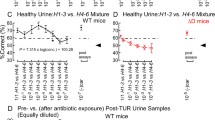Abstract
In order to test the hypothesis that commensal bacteria influence the urinary odors of individuality, we collected urine from PVG and PVG.R1 male rats born by cesarian section and reared in a germ-free environment. Using the habituation-dishabituation test with PVG.RT1 u and Lister hooded rats as subjects, we found that urine from the germ-free rats was not discriminated, while urine from conventionally housed rats of the same strains could be discriminated (experiment 1). When the germ-free rats were moved to a conventional animal house after recolonization with commensural flora and their urine collected, it was discriminated, indicating an essential role of bacteria in determining the unique urinary odors of MHC-congenic rats (experiment 2). The conventionally housed and germ-free rats did not differ in the amount of class I antigen in their urine (experiment 3). Finally, urines of PVG and PVG.R1 donors inoculated with a defined and highly restricted flora to render them specific-pathogen-free (SPF) could not be discriminated. Urine from SPF donors moved to a conventional animal house could be discriminated (experiment 4). These results indicate that commensal bacteria are essential for the production of the unique individual odor of the urine of MHC-congenic strains of rats.
Similar content being viewed by others
References
Albone, E.S. 1984. Mammalian Semiochemistry. John Wiley & Sons, Chichester.
Bjorkman, P.J., Saper, M.A., Samraoui, B., Bennett, W.S., Strominoer, J.L., andWiley, D.C. 1987a. Structure of the human class I histocompatibility antigen, HLA-A2.Nature 239:506–512.
Bjorkman, P.J., Saper, M.A., Samraoui, B., Bennett, W.S., Strominoer, J.L., andWiley, D.C. 1987b. The foreign antigen binding site and T cell recognition regions of class I histocompatibility antigens.Nature 239:512–518.
Brown, R.E. 1979. Mammalian social odors: A critical review.Adv. Stud. Behav. 10:103–162.
Brown, R.E., Singh, P.B., andRoser, B. 1987. The major histocompatibility complex and the chemosensory recognition of individuality in rats.Physiol. Behav. 40:65–73.
Brown, R.E., Roser, B., andSingh, P.B. 1989. Class I and class II regions of the MHC both contribute to individual odors in congenic inbred strains of rats.Behav. Gen. 19:659–674.
Brown, R.E.,Roser, B., andSingh, P.B. 1990. The MHC and individual odours in rats,in D.W. Macdonald, S. Natynczuk, and D. Muller-Schwarze, (eds.). Chemical Signals in Vertebrates V. Oxford University Press. In press.
Butcher, G.W., andHoward, J.C. 1986. The MHC of the laboratory rat,Rattus norvegicus, pp. 101.1–101.18,in D.M. Weir (ed.). Handbook of Experimental Immunology in Four Volumes, Vol. 3: Genetics and Molecular Immunology. Blackwell, Oxford.
Crozier, R.H. 1987. Genetic aspects of kin recognition: Concepts, models, and synthesis, pp. 55–73.in D.J.C. Fletcher and C.D. Michener (eds.). Kin Recognition in Animals. John Wiley & Sons, New York.
Diamond, A.G., Larkins, A.P., Wright, B., Ellis, S.T., Butcher, G.W., andHoward, J.C. 1984. The alloantigenic organization of the RT1.Aa, a class I major histocompatibility complex molecule of the rat.Eur. J. Immunol. 14:405–412.
Halpin, Z.T. 1986. Individual odors among mammals: Origins and functions.Adv. Stud. Behav. 16:39–70.
Holland, M., Rhodes, G., Dalleave, M., Wiesler, D., andNovotny, M. 1983. Urinary profiles of volatile and acid metabolites in germfree and conventional rats.Life Sci. 32:787–794.
Howard, J.C. 1977. H-2 and mating preferences.Nature 266:406–408.
Howard, J.C., Butcher, G.W., Galfre, G., Milstein, C., andMilstein, C.P. 1979. Monoclonal antibodies as tools to analyze the serological and genetic complexities of major transplantation antigens.Immunol. Rev. 47:139–174.
Kirk, R.E. 1968. Experimental Design: Procedures for the Behavioral Sciences. Brooks/Cole, Belmont, California.
Klein, J. 1986. The Natural History of the Major Histocompatibility Complex. John Wiley & Sons, New York.
Maryanski, J.L., Pala, P., Corradin, G., Jordan, B.R., andCerottini, J.-C. 1986. H-2-restricted cytolytic T cells specific for HLA can recognize a synthetic HLA peptide.Nature 324:578–579.
Oikawa, T., Toshida, M.C., Satoh, H., Yamashida, K., Sasaki, M., andKobayashi, H. 1984. Assignment of the rat major histocompatibility complex to chromosome 14.Cytogenet. Cell Genet. 37:558.
Pendry, A. 1984. The use of flexible film isolators for housing experimental animals.Lab. Anim. 18:131–134.
Singh, P.B., Brown, R.E., andRoser, B. 1987. MHC antigens in urine as olfactory recognition cues.Nature 327:161–164.
Singh, P.B., Brown, R.E., andRoser, B. 1988a. Class I transplantation antigens in solution in body fluids and in the urine: Individuality signals to the environment.J. Exp. Med. 168:195–211.
Singh, P.B., Brown, R.E., andRoser, B.J. 1988b. Soluble classical class I MHC antigens in solution in the body fluids, pp. 226–240,in P. Ivanyi (ed.). MHC + X: Complex Formation and Antibody Induction. Springer-Verlag, New York.
Yamaguchi, M., Yamazaki, K., Beauchamp, G.K., Bard, J., Thomas, L., andBoyse, E.A. 1981. Distinctive urinary odors governed by the major histocompatibility locus of the mouse.Proc. Natl. Acad. Sci. U.S.A. 78:5817–5820.
Yamazaki, K., Boyse, E.A., Mike, V., Thaler, H.T., Mathieson, B.J., Abbott, J., Boyse, J., Zoyas, Z.A., andThomas, L. 1976. Control of mating preferences in mice by genes in the major histocompatibility complex.J. Exp. Med. 144:1324–1335.
Yamazaki, K., Beauchamp, G.K., Bard, J., Thomas, L., andBoyse, E.A. 1982. Chemosensory recognition of phenotypes determined by theTla andH-2K regions of chromosome 17 of the mouse.Proc. Natl. Acad. Sci. U.S.A. 79:7828–7831.
Yamazaki, K., Beauchamp, G.K., Wysocki, C.J., Bard, J., Thomas, L., andBoyse, E.A. 1983. Recognition of H-2 types in relation to the blocking of pregnancy in mice.Science 221:186–188.
Yamazaki, K.,Beauchamp, G.K.,Bard, J., andBoyse, E.A. 1990. Single MHC gene mutations alter urine odour constitution in mice, pp. 000–000, m D.W. Macdonald, S. Natynczuk, and D. Muller-Schwarze, (eds.). Chemical Signals in Vertebrates V. Oxford University Press. In press.
Author information
Authors and Affiliations
Rights and permissions
About this article
Cite this article
Singh, P.B., Herbert, J., Roser, B. et al. Rearing rats in a germ-free environment eliminates their odors of individuality. J Chem Ecol 16, 1667–1682 (1990). https://doi.org/10.1007/BF01014099
Received:
Accepted:
Issue Date:
DOI: https://doi.org/10.1007/BF01014099




